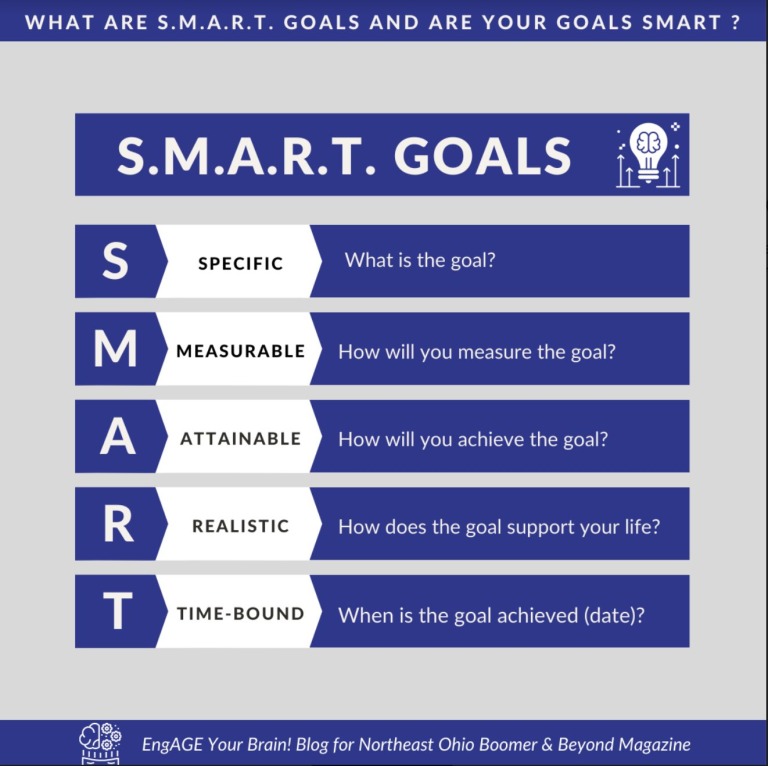This is the time of year when many people may set goals, resolutions or intentions for a wide variety of personal health and wellness goals that stretch from weight loss, finances, food, to fitness and more. While our personal goals are at the forefront of our minds, or at least at leading some conversations and news posts, I would like to offer one additional tool to support your optimal health journey: S.M.A.R.T. goals. Whether you are someone who has already honored the New Year or prefer not to set “New Year Resolutions,” this particular strategy can be applied to help achieve goals in different aspects of your life.
S.M.A.R.T.
“S.M.A.R.T.” is the acronym used for goal setting, typically in the workplace or business setting, but it can easily be applied to our health and wellness goals. Each letter offers guidance for how a goal should be written for optimal success. “S.M.A.R.T.” goals are a tool that can help us achieve our desired brain fitness resolutions or to get a former brain-healthy habit back on track.
To begin, let us learn what “S.M.A.R.T.” means and how it is applied to goal-setting.
S= Specific
M= Measurable
A= Attainable
R= Realistic
T= Time-bound
“S” = Specific
Goals must be specific, and the more specific the better! The desirable outcome for a goal should be very clear. For example, stating, “I will lose weight” is too broad to be useful. Rather, stating, “I will lose 10 pounds by June 1” is much more specific and clear. Write your goals to be as specific as possible.
“S” = Specific
Goals must be specific, and the more specific the better! The desirable outcome for a goal should be very clear. For example, stating, “I will lose weight” is too broad to be useful. Rather, stating, “I will lose 10 pounds by June 1” is much more specific and clear. Write your goals to be as specific as possible.
“M”= Measurable
The goal must be able to be measured to know if progress is being made and to know if the goal has been achieved. This should be very concrete and straightforward with no guesswork involved! For example, stating, “I will spend less money” cannot be measured. Rather, stating, “I will save an additional $100 per month” is easy to measure. Write your goals to be measurable and consider how you will measure each goal that you write. (Being specific will help with this.)
“A” = Attainable
Unfortunately, one of the initial missteps in goal-setting is creating goals that are not attainable. Feel free to make ambitious goals but strike a balance with crafting an achievable goal, as this supports motivation and overall goal completion. For example, stating, “I will work out everyday for the next 90 days” may not be attainable for most adults, as it may be unrealistic and unhealthy. An option might be to state, “I will work out for 150 minutes per week and aim to be “active” for at least five minutes daily.” For many, working out every day may not be an initial physical fitness goal but an advanced goal that is the end result of an increased fitness level over time (many years). However, movement throughout the day in small intervals can be readily achieved.
It is highly suggested to make smaller goals as stepping stones toward achieving larger goals and to celebrate the milestones along the way! (Make sure the “celebrations” do not derail the progress but encourage you to keep moving forward.) At the end of the day, you are accountable to yourself to accomplish your goals, and setting goals that are attainable at the onset help with success and future goal achievement.
“R” = Realistic
Your goals should be important to YOU. Read that again, please. It is very important that your goals align with your ambitions and are not driven by outside influences such as your family or friends wanting you to do something. Your goals should be practical for your circumstances and should be motivating for you. For example, it would be unrealistic to attend an expensive yoga class if it does not fit your budget and/or you really do not have an interest in learning yoga with your friends. Writing a goal to achieve this would not be to your own benefit. Instead, write a realistic goal for yourself that prioritizes your brain care, focused on something that is important to you and your life as it is now.
“T” = Time-bound
Make sure your goal has a specific time frame for completion attached to it. By placing a date to your goal, you have accountability and a sense of urgency for the goal. Now, with our “S.M.A.R.T.” goals, we have ways to measure our success along the way and know that “someday” is not a time-bound anchor point. Add a date to your goal and know it may not be an endpoint but a place to evaluate what is going well and what is not going well on your path to your goal.
For example, stating, “I want to read more” is a place to start, but how and when will you achieve this goal? Try stating, “I will read at least one book per month and read for 20 minutes every morning with my cup of coffee until the end of March.” This is a S.M.A.R.T.er brain fitness goal.
Summary
In wrapping up the writing of S.M.A.R.T. goals, think back to English class and the “6 W’s” in writing Who? What? When? Where? Why? How? When reading the goal that you wrote down, evaluate if it a S.M.A.R.T goal using the above acronym. If not, what is missing? Re-write the goal until it is S.M.A.R.T.er for your own success. The S.M.A.R.T. goal format is one tool for your brain health toolbox. Onward and upward in 2022 and beyond!
In brain health & wellness,
Krystal
Main image from Canva. SMART chart designed by Krystal Culler.
**Written for “EngAGE Your Brain!” blog series for Northeast Ohio Boomer & Beyond Magazine. Read the original article post here.


